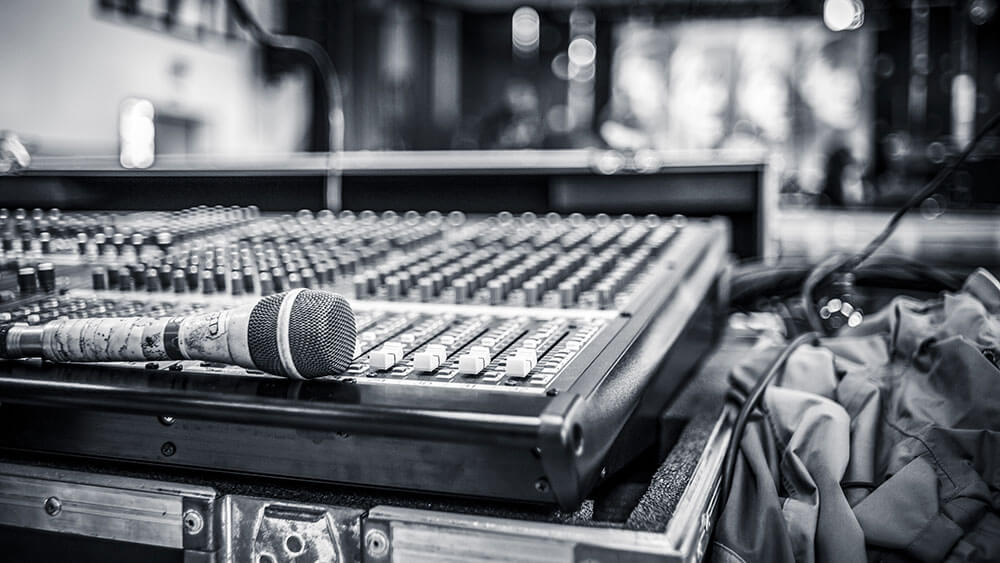
Getting the perfect sound mix at events and meetings can be difficult, but if you follow some best practices you’ll make some sweet noise.
As part of our May 2015 CMP Series story, Convene asked three leading AV providers to provide their best practices for fine-tuning the sound mix at your meetings and events. They cam up with these 10 tips for meeting planners.
1. Arrange speakers carefully. No, not your keynoters and other presenters — your audio speakers. “The placement of the speakers in the environment is very important,” said Jim Russell, executive vice president of sales for Freeman. “Sometimes the design elements of the room can take precedence over the sound, but it all needs to be done in conjunction for the best possible outcome.”

Jim Russell
2. Read the room. “Don’t think of audio as an easy piece of your set design — it has to be considered upfront, ideally at the time of site inspection,” Russell said. “Larger sessions, especially, can be a challenge.” There’s a pervasive myth that sound engineers can fix anything given the right equipment, and that’s true sometimes — but not all the time. “If there’s an echo in the room,” Russell said, “there will be an echo during a session, too.”
3. Remember, it’s called audiovisual. Ensure well ahead of the event that both audio and visual elements are in sync, to maximize your audience’s retention of meeting content. “If a person hears a message and looks at a related graphic,” said Mark Consiglio, product manager for audio and IT at PSAV, “he or she absorbs an additional 91 percent of the message.”
Michael Bogden, a sound designer and mixer at Visual Horizon Communications, agrees that coordinating audio and visual ahead of time is mission-critical. “Half of the content that the audience is getting in the meeting is what they’re seeing on the screen, whether it’s video or a PowerPoint presentation,” Bogden said. “If they can’t experience what’s on the screen, then the purpose of having that meeting is lost.”
4. Talk to your creative partners. Collaboration among your sound engineers, set designers, and the team in charge of visuals is also critical for the best audience experience. “Even though it might be the optimal speaker position, I can’t hang a speaker array in front of a screen, and if there’s an interesting scene-piece that plays a big part in the show, I can’t hang in front of that either,” Bogden said. “What I like to do, from the get-go, is sit down with everyone involved to find ways that I can design my speaker system into a piece of scenery, or to hang between two screens. The key is early and constant collaboration with everyone involved.”

Michael Bogden
5. Get the early-bird special. Budget is a huge driving force in sound design because it determines the size of your sound system and what equipment will be used on site. When you bring your sound team into the fold, they can offer suggestions and advice about making the most out of budgets of any size. Consiglio also recommends setting aside money for recording and livestreaming. “Don’t skimp on the labor or equipment recommended by your audio specialist,” he said. “We have spent a lot of time and energy determining the best way to ensure a successful event recording.”
6. Use the buddy system. On a related note, think of your sound provider as a partner, not a supplier. “We can help provide suggestions that would make a scenario that much better, but we can’t do that if we’re not at the table,” Bogden said. “Anybody can supply gear, but not everyone can be a partner. I think it’s important to be a really good partner.”
7. Understand the importance of silent sound. Bogden is frustrated when conference organizers treat audio as less of a priority. “I think there’s an attitude that ‘It’s just sound, it can just be okay,’” Bogden said. “The reality is that when sound is good it goes unnoticed, and when it’s not people notice right away.”

Mark Consiglio
8. Don’t automatically go wireless. Consiglio cautions against putting all your faith in wireless microphones for speakers — your sound provider may have a better suggestion for your particular meeting space or room setup. “One of the biggest misconceptions when dealing with sound design in the meeting space is that wireless microphones are 100-percent infallible, which is not the case at all,” Consiglio said. “Wireless microphones have a lot of variables, like interference and battery life, that can bring a meeting to its knees. In some cases, a wired microphone may be recommended, and that could be because the representative knows from experience that wireless mics could be an issue in that space.”
9. Consider what not to wear. It may seem like a minor detail, but presenters’ clothing can be a roadblock when it comes to wireless microphones, according to Bogden. Sweaters, dresses, and even earrings can make it difficult for the sound team to place microphones for optimal sound quality. Ask for advice early on, so you can brief your speakers well in advance of the meeting or request special equipment, such as necklace microphones. According to Consiglio, such specialty devices are perfect for speakers without a lapel or button-down shirt to connect a traditional lavaliere to. “They can be tucked under a scarf, a piece of jewelry, or even a collar on a dress shirt,” Consiglio said.
10. Go small or go home. “Everyone wants to try something new,” Bogden said. “They always want to experiment with something, whether it’s a new technology, a new piece of gear, a new application for a certain type of speaker, or a new design idea. The best piece of advice I got from a college professor was ‘Do that in very small steps.’ If you’re at a meeting and you want to try something new, just try one thing. Don’t do too many things at once, because you’ll increase the opportunity for failure. It would be a bad idea to try new microphones on all the presenters. If it doesn’t work, and the sound isn’t right, that’s a big deal.”
Kate Mulcrone is a Convene contributor.
Listen Up
That open-air room set is murder on your attendees’ concentration. Your keynoter’s voice is getting lost in the cavernous depths of the theater space. And the music at your cocktail reception is way too loud. But don’t worry — good sound design is as easy as listening to the audiology experts, meeting organizers, and AV professionals we’ve assembled.

